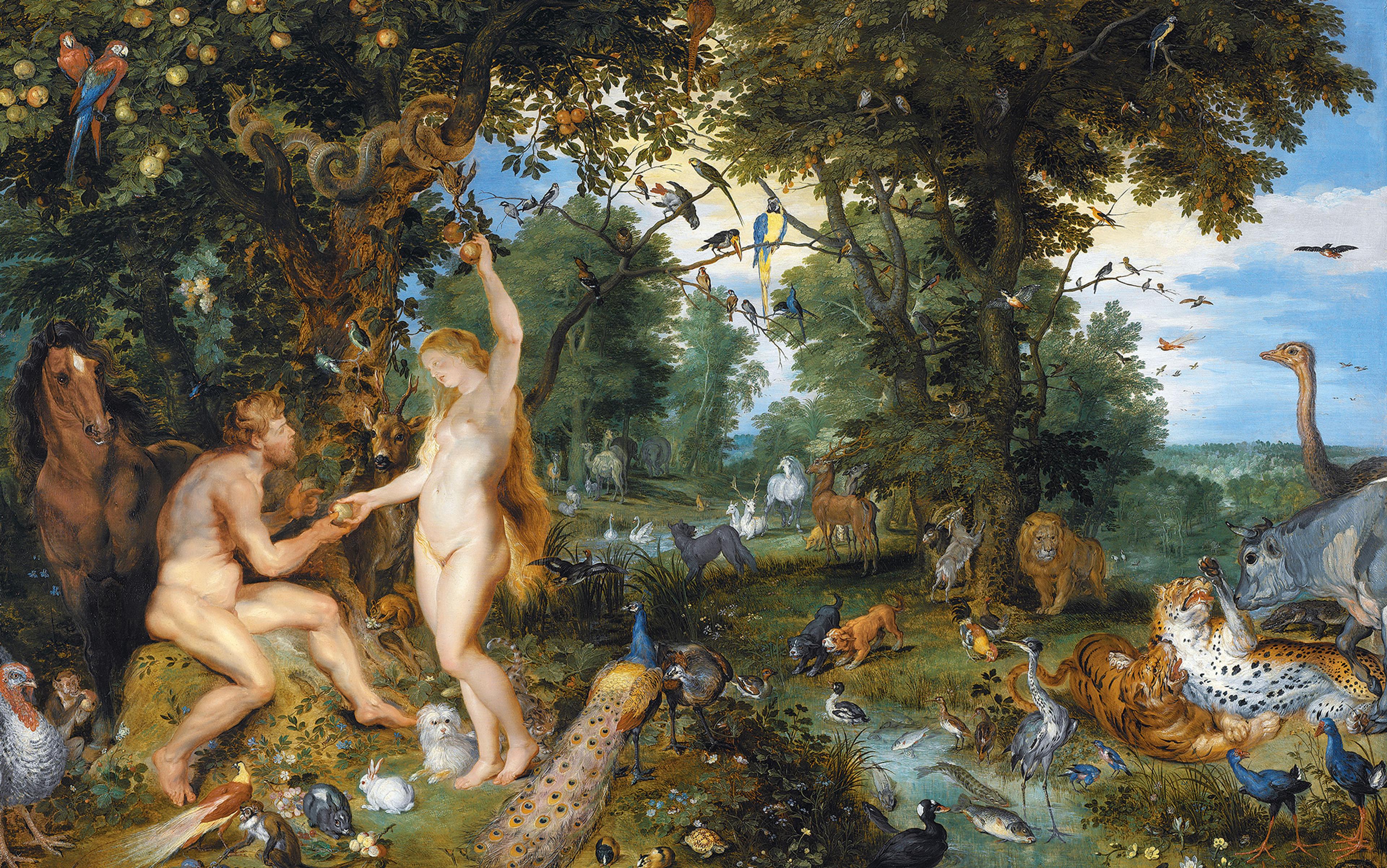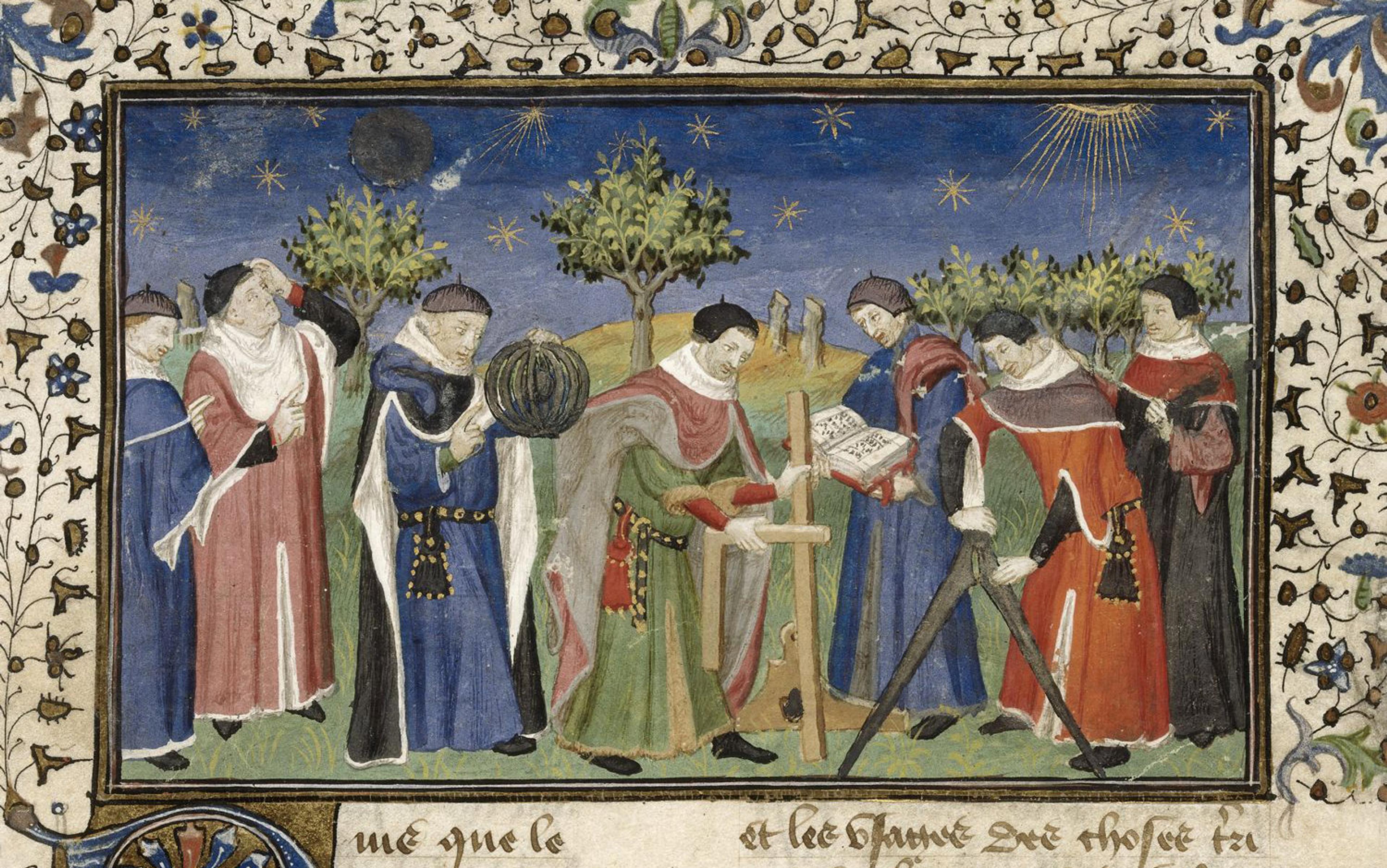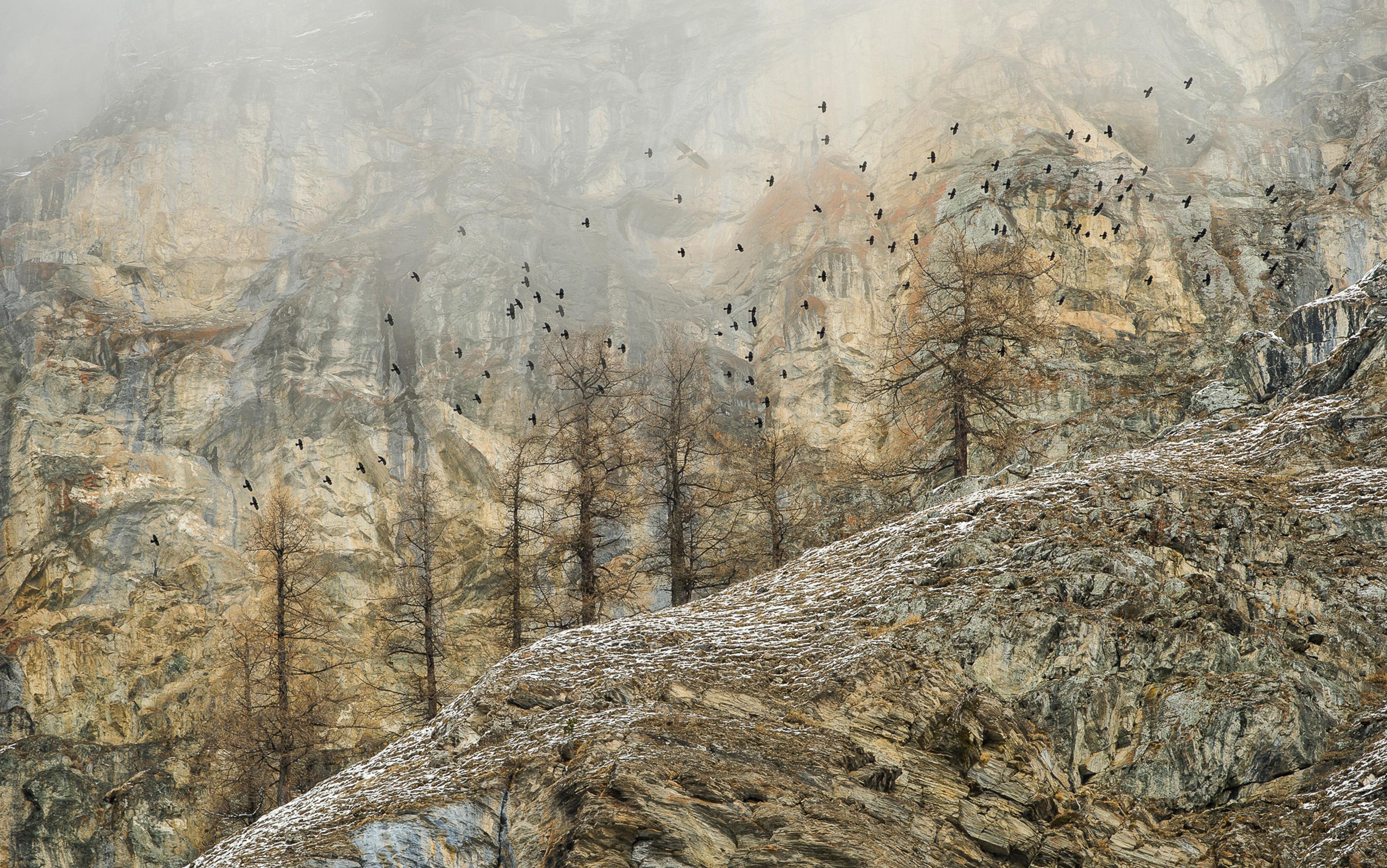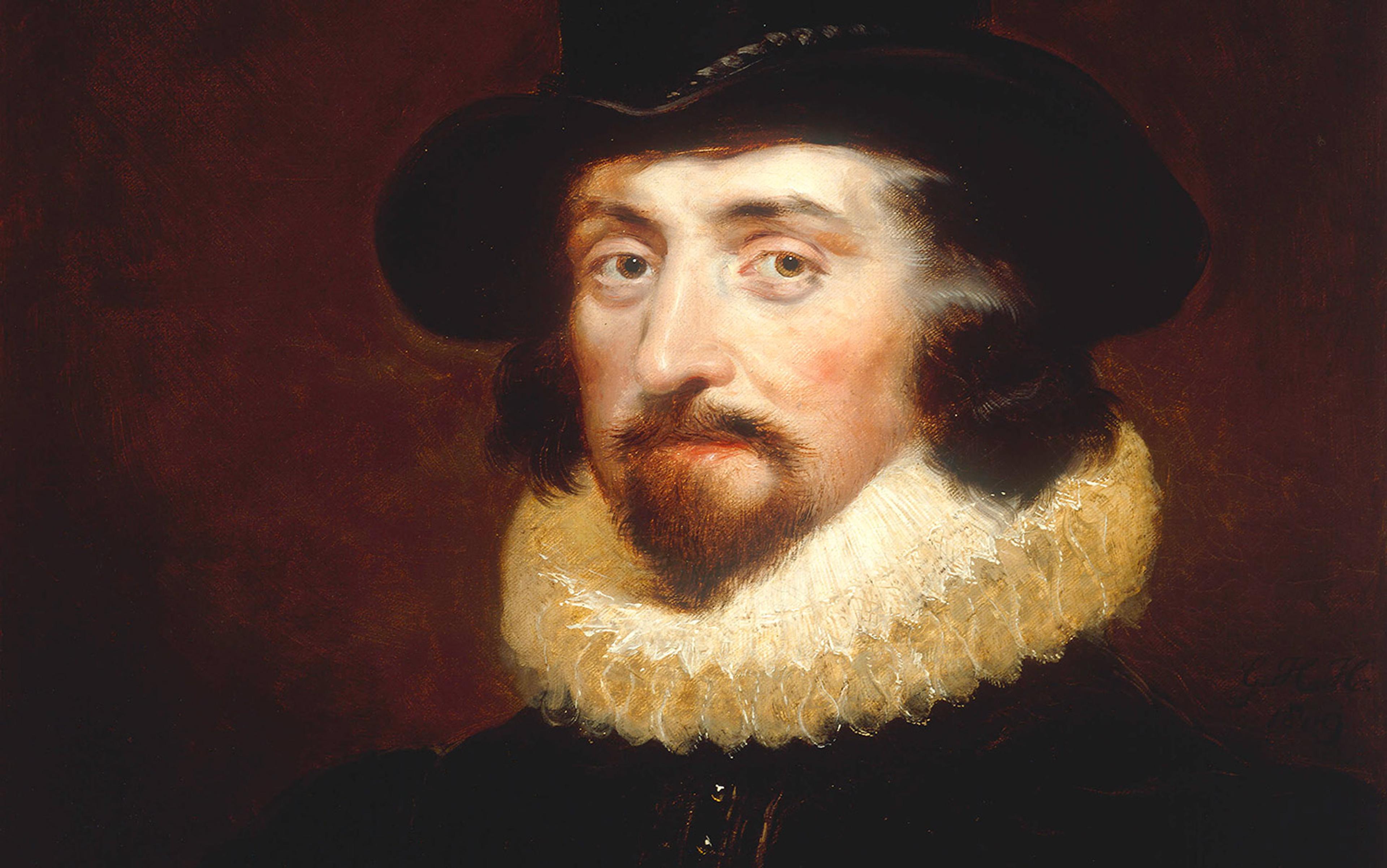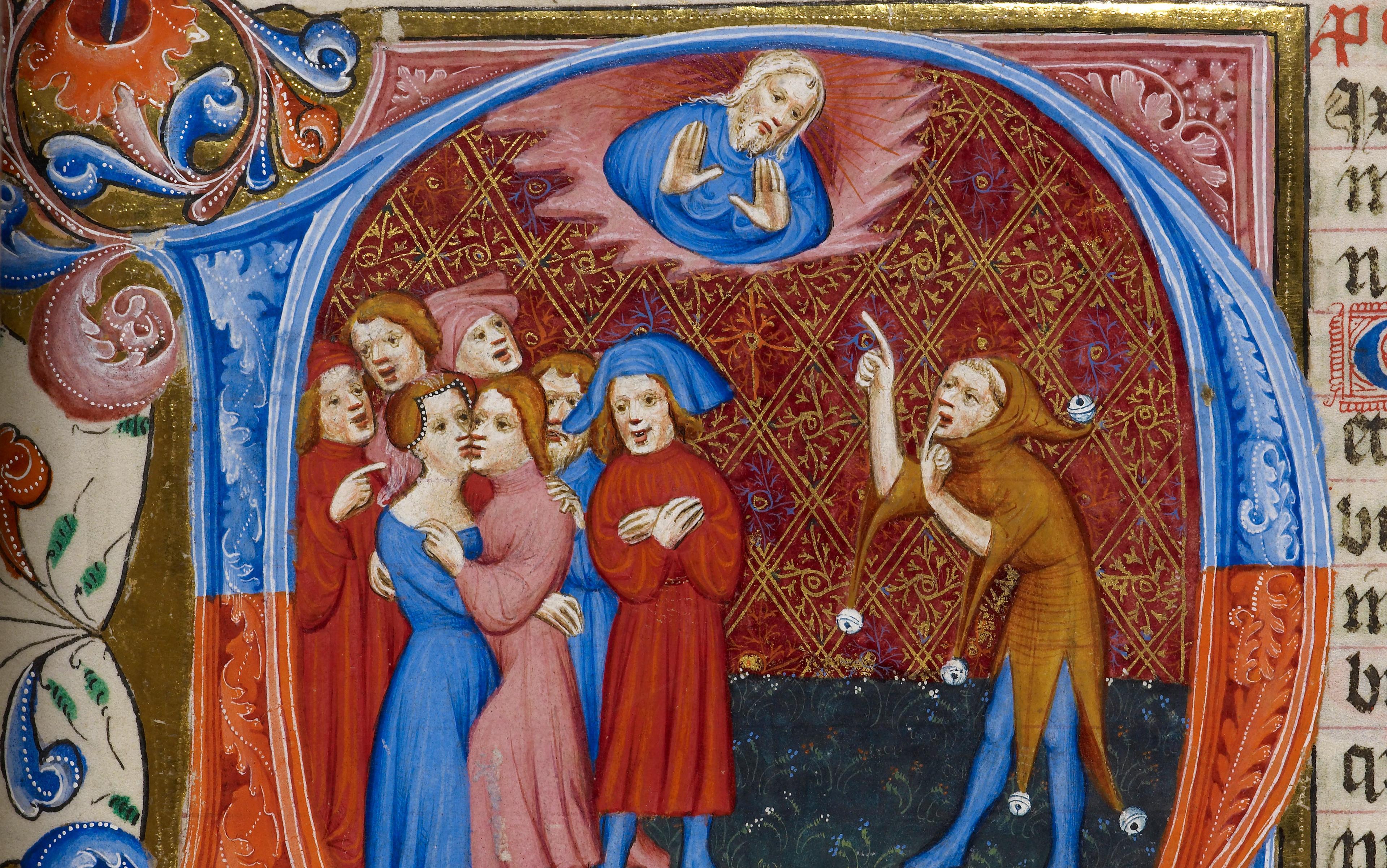There is a stubbornly persistent version of the history of science, much beloved of more than a few popular writers, that has science first emerging with the ancient Greeks, sliding into a moribund stagnation in the Christian Middle Ages, and bursting forth again in the 17th century with scientific heroes such as Galileo Galilei and Isaac Newton. In this cartoon version of history, the long medieval hiatus of science and reason is often attributed to the influence of religion. The scientific revolution of the 17th century and the triumphant march of science ever since are said to be a consequence of the fact that science managed to extricate itself from the clutches of a censorial and stultifying religious establishment.
What is wrong with this picture? For a start, the beginnings of something like scientific activity can be found in a number of cultures, not just Ancient Greece. As for the Middle Ages, historians of science have long been aware of the remarkable scientific achievements of medieval Islamic and Christian thinkers, and of the key role played by the medieval universities, which, from the 12th century, sponsored scientific speculation and debate. However, there is an important grain of truth to the popular three-phase narrative, because there really was something quite distinctive and revolutionary about the new sciences of the 17th century: new experimental methods, new combinations of mathematics and physics, the idea of science as a collective enterprise, revised understandings of nature and its meanings, and, crucially, the alignment of science with a set of values that would sustain it, and eventually propel it right into the centre of Western culture. But this revolution was not accomplished through a radical separation of science from religion: rather, at a number of levels, the successes of the new sciences were vitally dependent upon religious considerations, not least of which were the conditions generated by the Protestant Reformation of the 16th century.
In contending that Protestantism had an impact on the emergence of modern science, it is important to distinguish different ways in which this might have happened. First, distinctively Protestant doctrines or practices might have been relevant to the content or conduct of the study of nature. In addition to reinforcing the findings or methods of science, Protestantism might also have provided some of its presuppositions. Similarly, some versions of Protestantism might have fostered distinctive norms or attitudes – a Protestant ethic if you will – conducive to scientific activity. Less directly, it could be that the Reformation promoted a questioning of traditional authorities in a way that opened up possibilities for novel forms of knowledge, different social conditions, or new institutions for the pursuit of knowledge. Obviously, some of these likely influences belong to different possible modes, from theological to sociological. One thing we can be certain of is this: given the importance of religion to early modern European intellectual life, it would be remarkable if the tumultuous upheavals of the 16th century, and the subsequent schism between Catholics and Protestants, did not leave an indelible mark on an emerging modern science. The real question is how.
Already in the 17th century, people had linked religious reform to the reform of scientific knowledge. Nicolaus Copernicus and Paracelsus were dubbed ‘the Luther and Calvin’ of natural philosophy (‘natural philosophy’ being the label for what we now call ‘science’). Johannes Kepler was also known as the ‘Luther of astronomy’. More generally, the English philosopher Francis Bacon suggested that the reformation of the Church provided the model and inspiration for a renovation of knowledge more generally. Many other 17th-century thinkers echoed these sentiments. In this way, they turned to the Protestant Reformation to provide social legitimacy to fledgling scientific institutions promoting new methods and ideas.
Luther and other religious reformers represented their ‘new’ doctrines and practices not as novelties, but as a return to an original uncorrupted practice of religion. Both the humanist and reformation mottos ad fontes (to the sources) and sola scriptura (by scripture alone) express this important idea. Similarly, during the 16th and 17th centuries, it was commonly argued that new scientific theories were in fact revivals of some ancient teaching. Copernicus, in the Dedication of his classic De revolutionibus (1543) made a point of citing Cicero and Plutarch to demonstrate the great antiquity of his heliocentric model. (The work, incidentally, was dedicated to Pope Paul III, who had provided encouragement to the author.) Kepler dubbed Pythagoras ‘the grandfather of all Copernicans’, while Galileo also referred to the motion of the Earth as ‘a Pythagorean opinion’. New atomistic (or ‘corpuscular’) theories of matter were said, with some justification, to have been taught in antiquity by Democritus and the Epicureans. Newton sought to show that his natural philosophy agreed with Ancient Greek and Egyptian sages. Proponents also presented Copernicanism, atomism and other ‘advances’ as theories consonant with the views of the authors of the Hebrew Bible.
Associated with the quest to recover a pristine scientific and religious wisdom from the past was a mission to re-Christianise traditions deemed to have been tainted by paganism. Luther identified Aristotle as the main culprit, charging him with having contaminated both Christian theology and natural philosophy. Both church and university, he lamented, had become places ‘where only that blind, heathen, teacher Aristotle rules’. Lambert Daneau, the author of Physica christiana, or Christian Physics, (1576) and one of the most influential Calvinist thinkers of his time, sought to use scripture to ‘reform the works of the philosophers’. The Paracelsian mathematician and cosmologist Robert Fludd insisted that ‘the subject of true Philosophy is not to be found in Aristotle’s works, but in the Book of truth and Wisdom’. This strong tradition of ‘pious natural philosophy’, ‘Mosaic philosophy’ or simply ‘Christian philosophy’ represents a significant phase in the emergence of modern science. For while natural philosophers would eventually come to prioritise experience and experiment over written sources, the phenomenon of ‘Christian philosophy’ shaped the quest for new, non-Aristotelian sources for the study of nature. In essence, religious and scientific reformers helped to liberate the sciences from the strictures of Aristotelian philosophy.
Another perceived problem with Aristotle’s science was that it was based on a confidence in the unaided powers of human reason and the senses. Aristotle had taken the sanguine view that our cognitive and sensory powers were aligned with nature and would unproblematically yield a relatively accurate picture of the world and its workings. Aristotelian science was accordingly based on commonsense observations of nature, conducted without instruments or experiments. This approach gave rise to a number of familiar, but erroneous, Aristotelian doctrines: a heavy object (the stone) will always fall more quickly than the light one (the feather); terrestrial objects move in straight lines and will eventually come to rest; celestial objects move perpetually in circular paths.
Adam in his original and fallen states provided religious legitimacy for new scientific endeavours
For Protestant critics, the human fall from perfection – crucially, a fall that damaged both human moral capacities and sensory and cognitive abilities – fatally compromised Aristotelian scholasticism. Medieval Christian thinkers had acknowledged the Fall, but Luther and John Calvin contended that they had failed to take full cognisance of its implications for the sciences. Luther declared that ‘it is impossible that nature could be understood by human reason after the fall of Adam’. He went on to express skepticism about the scientific doctrines of ‘the heathen master’ Aristotle, who ‘taught and still teaches … that a stone is heavy, that a feather is light, that water is wet, and fire is dry’. Scholastic philosophers and university masters of arts, according to Luther, had accepted the false Aristotelian premise that ‘natural light or intellect and heathen philosophy are also safe means of discovering truth’. Calvin, too, insisted that as a consequence of the Fall ‘the whole soul is vitiated’, with the damage encompassing reason, the affections and the senses. For Luther and Calvin, both Aristotle and scholastic philosophers had underestimated the impact of original sin on the human capacity to acquire reliable knowledge.
One implication of the more robust version of original sin that Luther and Calvin held was that Adam, in his innocence, would have possessed a vastly more perfect knowledge of nature than his fallen progeny. A corollary to this claim of Adam’s encyclopaedic knowledge was that the biblical patriarchs knew the traditions of such Adamic science and that these had subsequently found their way into ancient written sources: Jewish, Babylonian, Egyptian and Greek. Again, this helps to account for the emphasis of aligning ‘new’ scientific theories with long-lost knowledge.
The contrasting conditions of Adam in his original and fallen states served to motivate scientific enquiry and provide religious legitimacy for new scientific endeavours. Bacon’s Novum Organum (1621), an influential manifesto for a new, non-Aristotelian science, announces that, after the Fall, human beings lost both their capacity to do good and their mastery of nature. Happily, though, these losses ‘can even in this life be in some part repaired; the former by religion and faith, the latter by arts and sciences’. Thus, for Bacon and other Protestant intellectuals, the Fall narrative provided human beings with a two-fold mission: to restore their fallen moral state through religion, and to restore their mastery of the world through the sciences. Early supporters of the Royal Society, founded in 1660, commonly spoke in theological terms about the new science recapturing a lost, pre-Fall human dominion over nature.
The new logic of experiment and systematic observation was also premised on the idea that reliable knowledge of nature would be hard to come by, both on account of wounded human capacities and because nature itself was no longer accessible in the way it once had been. Repeated sets of observations, conducted under specific conditions, would scrutinise a recalcitrant nature and help to compensate for human fallibility and cognitive limitations. At the same time, fallen human senses stood in need of artificial augmentation – most notably with the telescope and microscope. These instruments were admissions of human physical limitations in understanding the natural world.
The final piece of the Aristotelian paradigm to fall was the ideal that scientific knowledge would be been attainable by a few exceptional individuals. Now, instead, systematic study of nature could only be corporate and cumulative. Science would henceforth require the combined efforts of many minds, accumulated over the generations. These features of scientific investigation were together known as ‘experimental natural philosophy’, a radical new approach to knowledge that was contrasted with the insufficiently critical and interrogative methods of Aristotle.
The shift from a natural philosophy concerned with self-mastery to one that aimed at mastery of the world was related to Protestant ideas about the importance of the ‘active life’, and with a new understanding of vocation. The distinction between active and contemplative lives was a longstanding one in the Western tradition. In the Middle Ages, Christian thinkers kept faith with the classical consensus that elevated the contemplative life over the active life. Philosophical activity, including natural philosophy, was largely disengaged from practical, utilitarian concerns. Renaissance discussions reopened the question of the relationship between enquiry and worldly affairs, with a number of political philosophers arguing for the priority of the active life.
For different reasons, Protestant Reformers also challenged the superiority of the contemplative life, which they associated with an unhealthy monastic retreat from the world. Luther insisted that true Christians should avoid emulating cloistered monks, who in his view, crept into corners or retreated to the wilderness. Christians, he urged, should ‘use’ the world: ‘to build, to buy, to have dealings and hold intercourse with his fellows, to join them in all temporal affairs’. Calvin likewise maintained that in the present world Christians should devote themselves to ‘utility’, ‘profit’ and ‘advantage’. In this manner, they would then contribute to the building up of the commonwealth. These priorities were reinforced by references to Adam’s labours in the Garden of Eden.
Calvin’s teachings about the intrinsic value of work inspired Max Weber’s notions of a Protestant ‘ethic’, linked to the rise of modern capitalism. Whatever the merits of the Weber thesis, it is not difficult to see how these ideas might also have played a role in a new conception of science that focused on usefulness and active engagement with the natural world. Natural philosophy had traditionally focused on understanding rather than practical utility. Bacon and other scientific reformers derided this lack of worldly goals and argued that the study of nature be directed away from contemplation and personal edification and towards the practical task of restoring the empire of man over nature. Knowledge, Bacon insisted, is to be sought ‘not for the quiet of resolution but for a restitution and reinvesting (in great part) of man to the sovereignty and power … which he had in his first state of creation’. The Baconian programme for the study of nature aimed at a mastery of the natural world that would yield practical benefits. The rise of modern science was crucially dependent not just on new discoveries and experimental techniques but was also driven by these new values.
This elevation of the active life went hand-in-hand with Lutheran and Calvinist notions of the sanctity of earthly vocations. The priesthood, on this view, was no more religious a vocation than any other. ‘All Christians,’ Luther maintained, ‘are of the spiritual estate, and there is no difference among them except that of office.’ Calvin strongly supported this ‘priesthood of all believers’. This general principle meant that for the first time the formal study of nature could be regarded as a priestly activity. The ideal of the scientist-as-priest would subsequently become a common motif among 17th-century Protestant natural philosophers. Kepler, for example, had originally studied theology at Tübingen with the intention of becoming a Lutheran minister: ‘I wished to be a theologian; for a long time I was troubled, but now see how God is also praised through my work in astronomy.’
Robert Boyle, one of the founders of modern chemistry and a pioneer of experimental methods, spoke in similar terms of the priestly role of scientific investigators. The study of nature, he claimed, was ‘the first act of religion, and equally obliging in all religions.’ Boyle captured the Protestant spirit of the new science perfectly: ‘Discovering to others the perfections of God displayed in the creatures is a more acceptable act of religion, than the burning of sacrifices or perfumes upon his altars.’ Kepler, Boyle and others saw their scientific work as part of a religious mission to uncover the divine order of the natural world. Again, then, values derived from Protestant ideas of vocation motivated at least some of the most influential scientists of the period, and provided a religious rationale for pursuing the study of nature.
A cosmos evacuated of symbolic meanings made space for alternative ways of ordering the natural world
For theological justification, the new Protestant directives in the sciences looked to specific biblical warrants. Most importantly, they used the Bible to support a new experimental framework for the sciences, including a new practical orientation and a novel set of critical methods. As we have seen, reformers paid particular attention to the biblical figure of Adam, making a special case in regard to the difference between his innocent and fallen states. Behind these appeals to biblical authority lay the core Protestant principle of sola scriptura. This principle involved an elevation of the authority of scripture to a pre-eminent position, along with an advocacy of reading it in a literal way.
Contrary to popular misconceptions, learned people in the past were not slaves to biblical literalism. Patristic and medieval exegetes often understood the bible allegorically. The logic of allegory is simple, if often misunderstood: in a literal reading of scripture, a word refers to a thing; in an allegorical reading of scripture, things refer to other things. Thus, allegorical reading depended on the assumption that objects in the natural world bear meanings. When scripture refers to these objects, readers are invited to contemplate their deeper theological significance. So allegory is not just about written works, it carries consequences for our understanding of natural objects.
In the 13th century, Thomas Aquinas put it plainly: ‘The author of Holy Writ is God, in whose power it is to signify His meaning, not by words only … but also by things themselves.’ The idea that nature could be ‘read’ in this way underpinned the medieval commonplace of nature as a ‘book’ to be read in parallel with the book of scripture. Allegory, in short, was a practice that brought together the reading of the book of nature and the book of scripture. In consequence, a change to the status of allegorical interpretation would necessarily have implications for how nature was conceptualised.
Protestant reformers campaigned against the excesses of allegorical interpretation. Luther maintained that the literal sense was ‘the highest, best and strongest sense’. Allegory was for ‘weak minds’. Calvin also cautioned against wild allegorising, insisting that ‘the true meaning of Scripture is the natural and simple one’. This opposition to allegory, however, necessarily had implications for the understanding of nature. It meant that the theological significance of things in nature could no longer reside in their symbolic meanings. Together, with iconoclasm, condemnation of idolatry, diminution in the number of sacraments, and the shift in the focus of worship from images and rites to words, this amounted to a Protestant assault on the symbolic worldview of the Middle Ages, on what C S Lewis described in The Discarded Image (1964) as ‘a single, complex, harmonious mental model of the universe’.
A cosmos evacuated of symbolic theological meanings made space for alternative ways of ordering the natural world. No longer a ‘book’ replete with symbolic objects bearing hidden theological meanings that could be revealed through contemplation and allegorical interpretation, it became instead a material resource to be exploited and mastered for human benefit. Experimental science provided the means to accomplish this. As for the multiplicity of rich theological meanings, these were contracted into discrete sets of ‘arguments’ for the wisdom and power of God, now evidenced in the designs and contrivances of natural things. In the 13th century, the Franciscan Bonaventure could claim that: ‘The creature of the world is like a book in which the creative Trinity is reflected, represented, and written.’ In the 17th century, Bacon demurred, insisting that the works of God ‘show the omnipotency and wisdom of the maker, but not his image’.
Thus, while these new readings of nature represent a clear break with medieval contemplative and allegorical approaches, they were no less imbued with religious significance. A powerful new alliance between theology and science replaced allegory. Its theology can be seen in the new ‘book of nature’ metaphor. Ways of reading the world theologically were now provided by the new sciences. Kepler and Galileo maintained that mathematics provided the key to interpreting the book of nature; for Boyle, it was physiology that offered a way of reading the creatures.
In essence, the Protestant reformers’ literal approach to scriptures brought two basic changes to making a new science. First, it hastened the collapse of the symbolic universe of the Middle Ages. In this way, it made for alternative ways of reading and ordering the natural world. Experimental natural philosophy allied with natural theology came to define an approach to investigating the cosmos. Second, the Protestants’ literal apprehension of the scriptures, in particular the Fall, came to motivate scientific activity that could now be seen as a redemptive process to restore nature and extend human dominion over it.
It is worth considering, finally, some of the ways in which, in the aftermath of the Protestant Reformation, the natural sciences came to enjoy an increasing prominence and epistemic authority. It is important to understand that, at the time of its emergence, there was nothing obvious about the virtues and usefulness of the new experimental science. On the contrary, many regarded it with considerable suspicion, and it was subjected to searching criticism and even ridicule. The advocates of experimental science found themselves needing to devote considerable effort to establishing the utility of their fledgling enterprise, and aligning it with existing values. In these efforts, the partnership of natural philosophy and natural theology proved vital. It established the new science with religious credentials and much-needed social legitimation. The authority of natural theology helped to make natural science a mainstream activity in the modern West. This alliance also helps to explain how early modern Europe managed to break out of the boom-bust cycle that characterised the scientific cultures of other places and historical periods.
Religion also benefited from this partnership, at least at first. The Protestant Reformation unleashed in vexing and potentially chaotic ways the problem of religious pluralism. The advocates of each religion insist that only one religion – their own – is true. The discordance raised the spectre of atheism: what if, after all, competing religions cancelled each other out? In such an environment, the alliance of natural science and natural theology offered protection against impiety and unbelief, and support for the truth of religion in general. Indeed, the new alliance between natural theology and natural philosophy produced potent evidence for the wisdom and power of God, support more solid, it was claimed, than the more philosophical and speculative arguments of the medieval era, which were light on empirical evidence.
Some pious natural philosophers even argued that their enterprise could establish the truth of Christianity, and even of specific Christian creeds. Boyle put it plainly, writing that ‘the New Philosophy may furnish us with some new Weapons for the defence of our ancientest Creed’. He also argued that experimental science better equips one to discover ‘Solid Arguments for Natural, or Reveal’d, Religion … how remote soever those Truths may be from vulgar Apprehensions.’ Joseph Glanvill, an Anglican clergyman and Fellow of the Royal Society, agreed that the new philosophy helped to establish ‘the Infallible truth of Scripture History, and twists such a cord as is as strong as any thing in Geometry or Nature’.
‘Acquaintance with nature assists RELIGION against its greatest Enemies … Atheism, Sadducism, Superstition’
Such arguments often rested on a belief that natural philosophy confirmed the occurrence of certain events recounted in scripture (such as Noah’s flood). Even more specifically, some natural philosophers imagined that their enterprise would enable a more discriminating choice among competing Christian confessions. Natural philosophers, after all, excelled at assessing the relevant testimony and evidence that provided external support for specific beliefs. Boyle thus claimed that experimental natural philosophers ‘will examine with more Strictness and Skill, than Ordinary Men are able, Miracles, Prophecies, or other Proofs, said to be Supernatural, that are alledg’d to Evince a Reveal’d Religion’.
Post-Reformation confessional controversy, then, offered a new context and a task for natural philosophy. It was to assess the broad spectrum of religious possibilities, from the extremes of atheism to the unchecked enthusiasm associated with more radical Protestant sects. Somewhere in the middle of this new array of possibilities lay the ‘superstitious’ and credulous Catholicism as well as a more sober, but equally flawed, deism. Proponents of natural philosophy contended that their enterprise offered a way of analysing this spectrum of possibilities and arriving at the true place. Making the case for an irenic Anglicanism, Glanvill maintained that ‘acquaintance with nature assists RELIGION against its greatest Enemies, which are Atheism, Sadducism, Superstition, Enthusiasm, and the humour of disputing’.
The new natural philosophy offered the appropriate expertise for making the relevant judgments. Its practitioners were even disinterested: ‘He is fittest to commend divinity,’ wrote Boyle, ‘whose profession it is not.’ In the age of ‘evidences’ – itself an outcome of the religious pluralism that followed the Protestant Reformation – the natural sciences thus came to offer a ‘neutral’ epistemic space from which the relative merits of competing ‘religions’ could be evaluated. This ceding of authority to the natural sciences would bring momentous consequences. It would help in securing their epistemic authority and establishing the conditions for their subsequent assumption of the social status once enjoyed by religion.
Philip Pullman’s fantasy trilogy His Dark Materials (1995-2000) is built upon the wonderfully imagined conceit of a world that is parallel to ours in many ways. But with one vital difference – the Protestant Reformation never happened. Pullman’s books serve as a salient reminder that there was nothing inevitable about the emergence and valorisation of science in the West. Science does not unfold in history according to some inexorable, inner logic, if for no other reason than that the constituents of ‘science’ itself are not a historical constant. Western science could have turned out differently, in multiple ways. Even if its content were the same, its position in society and the values that attend it could have been otherwise. Science in the modern world, as we know it, owes much to contingent factors, among them the Protestant Reformation and its unforeseen aftermath. My clear suggestion has been that the methods of modern science, its theoretical content, and its social significance all owe something to Protestantism.
Pullman’s counterfactual world also provides us with an opportunity to reflect on what might have been if, at the dawn of Western modernity, there had not been the complex alliance of the new science with new religious values – no emergence of the idea of a natural world that was to be mastered, dominated and exploited rather than simply contemplated; no astonishing technologies, medical advances and material affordances that a utilitarian science has generated; and, against all this, perhaps no impending ecological catastrophe that threatens all of these apparent gains and perhaps more besides.
For now, though, it is worth returning to the Protestant actors who first drew attention to a connection between the reformation of religion and the reformation of the sciences, to sound a final note of caution and reflect upon some of the ironies of history. Almost from the first, Protestants sought to associate a particular version of history with Protestantism, reason and progress. They likewise insisted that Catholicism was part and parcel of superstition, censorial attitudes and scientific backwardness. This Protestant historical consciousness lent itself to a progressivist Enlightenment narrative that promoted a similar view of history. It is this contentious historiography, deeply imbued with residual anti-Catholic sentiment, that informs the simplistic picture of the history of science with which this piece began.
By the end of the 19th century, this anti-Catholic propaganda broadened into a general historical critique of the relations between Christianity and science. This is when arose the now-familiar ‘conflict myth’ that makes little distinction between forms of religion, and simply asserts that Western history is characterised by an ongoing battle between science and religion. It is ironic that this conflict myth owes not a little to the way in which Protestant apologists first constructed their own history. In a sense, the animus against religion exhibited by some contemporary advocates of scientific enlightenment is simply an extreme version of this ‘Protestant’ position.
It is also ironic that the original early modern partnership forged between science and Protestant religion has ultimately corroded religious authority. It was pious advocates of the new natural philosophy such as Robert Boyle who, amid apparently irresolvable religious disputes, ceded authority to a putatively neutral third party – natural philosophy. Eventually, Christianity came to be understood, in part, as a series of propositions that stood in need of scientific support. Science thus came to gain the upper hand over religion. For now, it shows little sign of wanting to relinquish it.
